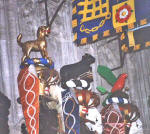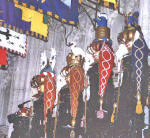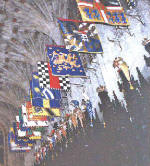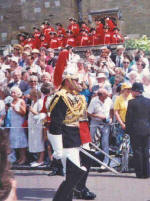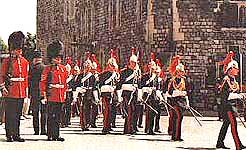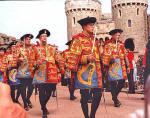|
The Most Noble Order of the Garter
from
HeraldicSculptor Website
The Oldest and Highest
British Order of Chivalry, founded in 1348 by Edward III
The Order consists of Her Majesty The Queen who is Sovereign of the
Order
His Royal Highness The
Prince of Wales and 24 Knights Companions
The origin of the symbol of the Most
Noble Order of the Garter, a blue 'garter' with the motto Honi Soit
Qui Mal Y Pense will probably never be known for certain as the
earliest records of the order were destroyed by fire, however the
story goes that at a Ball possibly held at Calais, Joan Countess of
Salisbury dropped her garter and King Edward seeing her
embarrassment picked it up and bound it about his own leg saying in
French, Evil, (or shamed) be he that that thinks evil of it' this is
almost certainly a later fiction. This fable appears to have
originated in France and was, perhaps, invented to try and bring
discredit on the Order. There is a natural unwillingness to believe
that the World's foremost Order of Chivalry had so frivolous a
beginning.
It is thought more likely that as the garter was a small strap used
as a device to attach pieces of armour, it might have been thought
appropriate to use the garter as a symbol of binding together in
common brotherhood. Whilst the motto probably refers to the leading
political topic of the 1340's, Edward's claim to the throne of
France. The patron saint of the Order of the Garter is St George and
as he is the patron saint of soldiers and also of England, the
spiritual home of the order has therefore always been St George's
Chapel in Windsor Castle.

HM the Queen during
the Order of the Garter Procession outside St George's Chapel
Windsor Castle
The holders of this Order as a Knights
Companion, entitles the recipient the right to use the title 'Sir'
before their Christian names as well as being entitled to add the
letters 'K.G' ( Knight of the Garter ) or in the case of a Lady
Companion 'L.G.' Lady of the Garter, after their surnames or title.
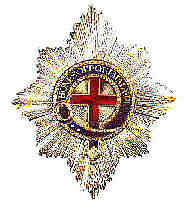
The Order of the
Garter Star
King George III's
diamond Star made in around 1800, is worn on the left breast,
it had a 13-stone
ruby cross centre set amongst diamonds in gold, encircled by the
Garter in blue enamel.
The
Order of the Garter, Its History and Ceremony
The Most Noble Order of the Garter is one of the oldest and most
important of all such Orders throughout the world, with the concept
of like minded brotherhood dedicated to service and chivalry, these
core principals having survived intact and are as relevant today as
at its conception over 650 years ago. With almost a thousand
appointments of royalty, soldiers, statesmen, favourites, magnates,
and a few traitors having been made since 1348.
It was during the 11th and 12th centuries within the warrior-classes
the idea of the medieval notion of chivalry and knighthood first
developed. The Crusades in the Middle East had released these men
from the previous constraints of feudalism. They could now express
their new-found identity by the creation of religious and military
orders of chivalry. The earliest orders of knighthood were amongst
groups of like-minded men who being drawn from a particular social
class were therefore bound together in a common purpose.
It requires all members to assemble at Windsor on the eve of the
feast day. The Knights and Ladies put on the mantle of the Order and
the Greater George and go to St George's Chapel for a service of
thanksgiving. They then sup at the Dean's House. On St George's Day,
the members attend a lunch in the Waterloo Chamber
Then all go in procession to the Chapel for service wearing the full
robes of the Order, including black velvet hats with white plumes,
and any new members are installed. On the day after, the mantle only
is worn. The Garter itself is worn throughout. The Greater George
must be worn on all official holidays, on Ascension Day, at the
funeral of a member of the Order, and when a member of the Order is
created a Peer.
Although the original medieval membership of the order consisted of
the British sovereign and the prince of Wales, each with 12
companions, as if at a tournament. Membership was expanded in the
late 18th and early 19th centuries to include supernumeraries such
as members of the royal family (known as "royal knights
companions"), lineal descendants of George I and George II, and
foreigners (known as "extra knights"). The British sovereign and
prince of Wales are always members of the order. Originally,
existing knights elected new knights, but now appointment to the
order is solely at the discretion of the British monarch. Women have
been made ladies of the order, but they are not ranked among the 25
knights companions.
The foundation of the Order of the Garter by King Edward III in the
early fourteenth century, brought together in close companionship
the Sovereign and twenty-five of the most outstanding military
leaders of the country at that time as a means of marking and
securing alliances; it also established a new fellowship in
religious worship ' to the honour of Almighty God, the glorious
Virgin Saint Mary and Saint George the Martyr'.
Since foreign monarchs have been appointed to the Order from the
fifteen century, one of the earliest such appointments was the Duke
of Urbino by Edward IV in 1474. Such appointments were and are
occasionally made to non-Christian rulers ( for example, the Shah of
Persia in 1902 ), which prompted some debate over the possibility of
removing Christian imagery ( the cross of St George ) from the Order
when it is given to non-Christian recipients; in the end however the
design remained unchanged.
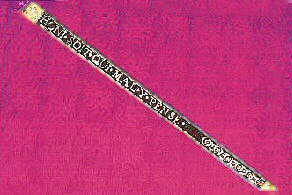
The Garter
Prince Albert's Garter was made in 1840
and was worn by the Knights beneath the left knee and by the Ladies
above the Elbow. The Garter's motto 'Honi Soit Qui Mal Y Pense' is
set in diamonds on dark-blue velvet, and the buckle is set with one
small and seven large brilliants.
Knights of the Garter
It was thought that in 1344 King Edward
III inspired by the legend of King Arthur and the Knights of the
Round Table, made a spectacular demonstration of his interest in
Arthurian legend during a massive joust at Windsor Castle. He also
promised to renew King Arthur's fraternity of knights with all the
paragons of knightly virtues with a complement of 300 men. Work also
even began on a gigantic circular building two-hundred feet across
within the upper ward of the castle to house this so-called Order of
the Round Table. The renewal of war with France intervened with this
project but in 1348 it was revived in a different guise.
Originally it was intended that the Order of the Garter was to
consist of twenty four knights, however during 1349/50 it consisted
of himself as Sovereign together with twenty five Knights Companion,
one of whom was the Prince of Wales, the black Prince. These
'founder knights' were military men, skilled in battle and
tournaments, few of these knights were much over the age of 30 and
four were under the age of 20. The other founder-knights had all
served in the French campaigns of the time, including the battle of
Crécy and three were foreigners who had previously sworn allegiance
to the English king, making twenty six knights in all. it was
intended by Edward III to be reserved as the highest reward for
loyalty and for military merit.
These Knights included some who owed allegiance to King Edward not
as King of England, but as Lord of Gascony . These Companions were
known as Stranger Knights a distinction from subjects of the English
Crown. Such was the prestige of the Order that during the next
hundred years Foreign monarchs in the Order are admitted and known
as 'Stranger Knights' and are in addition to the number allowed by
statute.
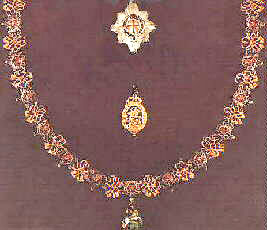
The Regalia
The Collar is of gold and weighs 30 troy
ounces and consists of twenty six red enameled Tudor roses each
interspersed with twenty six gold knots with a pendant representing
St George and the Dragon. The roses and knots are placed alternately
and joined to each other by gold links.
The insignia of the Order has gradually developed over the
centuries, starting with a garter and badge depicting St George and
the Dragon. A collar was added in the sixteenth century with the
star and broad ribbon being added in the seventeenth century.
Although the collar could not be decorated with precious stones (the
statutes forbid it), the other insignia could be decorated according
to taste and affordability.
As part of the original College of St George, Edward III established
a community of twenty-six impoverished military veterans known as
'Poor Knights' who were required to pray daily for the Sovereign and
the Knights of the Garter during life and also for their souls after
death. In return they received maintenance and lodgings in Windsor
Castle. These number of twenty-six was reduced to thirteen by
Elizabeth I at the request of her father Henry VIII.
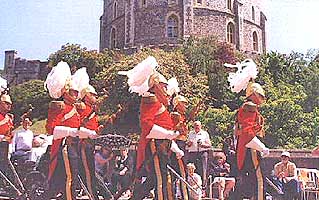
The Military Knights
During the early years of the nineteenth
century these Poor Knights who were all retired army officers,
objected to being termed 'poor' and petitioned the Sovereign William
IV to be allowed to wear the uniform of Unattached Officers a
uniform and to change their name. In 1834 the name was subsequently
changed to Military Knights and the members no longer had to wear
their red cloaks but instead were allowed to wear their new uniforms
with its plumed and cocked hat which is still worn today.
Each newly appointed Knight, or more recently Lady of the Order is
assigned a stall in St George's Chapel Windsor from which their
Banner displaying their coat of arms is hung. Beneath the banner is
a Knights helm (helmet) on which is placed the carved and painted
representation of the Knights Crown or Crest. In the case of
Stranger Knights who are Sovereign, Princes or Princesses, instead
of a carved Crest their carved and gilded representation of the
State Crown is placed upon the Knights helm. For Ladies Companion,
who, as women by the rules of English Heraldry have no right to a
Crest, a Coronet of rank, if they are a peeress, is placed upon the
helm.

A small selection of
over seventy five Crowns, Coronets and Crests that have been carved
and painted
by Ian G Brennan
before they were placed in St George's Chapel Windsor and Henry VII
Chapel
in Westminster Abbey
for the Knights of the Most Noble Order of the Garter and Most
Honourable Order of the Bath.
top row - Lavinia, Duchess of Norfolk - HM King Juan Carlos I
of Spain - Baroness Margaret Thatches - Lady's and Knights of the
Order of the Garter
bottom row - Lord Beetham - Sir Frank Cooper - Sir Henry
Leach - Knights of the Order of the Bath.
Crowns, Coronets and Crests for the
Royal Knights, Extra Knights and Ladies, Knights and more recently,
Lady Companions of the Most Noble Order of the Garter have been
placed above the Knights stalls ( seats) in St Georges Chapel in
Windsor Castle for almost six Centuries. The latest Ladies and
Knights of the Garter are officially announced on 23 April; St
George's Day from Buckingham Palace. For almost twenty years all the
carved, painted and gilded Crowns, Coronets and Crests for the Order
of the Garter have been produced by sculptor Ian G Brennan. They are
mostly carved from lime wood which Ian then paints and gilds and are
between 12 - 28 inches high.
The Knights Crests were originally worn on top of the Knights helm
(helmet) during pageants and tournaments in the fourteenth century
and used as a form of identification. Fighting at tournaments were
also a good way of training for battle. Each Crest Ian produces
which is placed upon a wreath he also carves from lime wood to
represent a circle of two twisted ropes of silk, each of a different
colour. The original purpose of the wreath was to disguise the join
between the helm and the Crest. Up until the seventieth century all
the wreaths in St George's Chapel were still made from actual
twisted cloth, however since that time they have all been carved
from lime wood.
A carving by Ian G Brennan recently commissioned to be placed in
Westminster Abbey is of a Medieval Knight in full battle armour
having scored a point whilst riding in tournament, depicted by the
Knights broken lance. When a Knight was jousting he would try and
score the best of three points from three lances to win the match.
The Knights lances were tipped with Cornell's which blunts them so
as to reduce the chance of serious injury to the opponent.
One point is made by breaking the lance between the waist and neck
of the opposing Knight. Two points we made by breaking the lance on
the helm of the opponent, this was more difficult to do as the head
sweeps back with the force of the blow which would often leave the
lance unbroken. Three points would be made by breaking the lance and
also bringing the rider to the ground. The victor on this occasion
would also win the defeated knights horse. Only Knights of Noble
birth over at least three generations would be allowed to ride at
tournament.

Ian's wood sculpture
of a Knight
celebrating winning a
point at tournament commissioned for Westminster Abbey
For almost two centuries each year,
usually at St George's - tide in April the Sovereign and Knights of
the Garter met at Windsor Castle for a Festival which lasted for
three days. They gathered in Chapter, feasted in St George's Hall
and occupied their stalls in St George's Chapel for Matins, the
Eucharist, Evensong and Requiem for departed Knights. From 1674
onwards until 1805 services were held less frequently and during the
remainder of the 19th century the life of the Order was restricted
to Chapter meetings for investitures and elections normally held in
London.
In 1948 His late Majesty King George VI commanded the Knights of the
Garter to once again assemble at Windsor Castle for a Chapter
meeting, to Process through the Castle and to have a Service at St
George's Chapel. Since that time a Garter Day of this type has been
regularly held each June. The procession taken by the Garter Knights
from the Upper ward to the Royal Chapel is a public witness to the
long tradition of the Sovereign and the leaders of the nation giving
their allegiance and thanksgiving to God for creating, renewing and
sustaining the World.
The number of Knights Companion remained at twenty six until the
reign of George III when additional or Supernumerary appointments
were made. Firstly from 1786 all the sons of the Sovereign were
declared to be eligible to be appointed in addition to the twenty
six ( George had nine sons ) From 1805 the Prince of Wales upon his
creation immediately become a member of the Order of the Garter. In
1813 all Stranger Knights were appointed as Supernumerary.
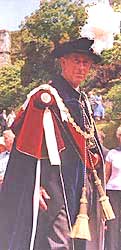 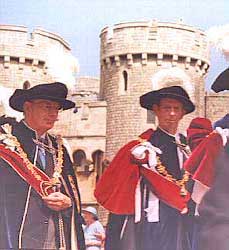
HRH Prince Charles
The Prince of Wales, along with HRH The Duke of Gloucester and HRH
The Duke of Kent wearing the blue velvet robes and black velvet hats
with white plumes, as worn by the Knights of the Garter during the
Garter procession at Windsor Castle
From the Eighteenth century to 1946,
appointments to the Order of the Garter were made on advice from the
government. Today the Order has returned to its original function as
a mark of royal favour ; Knights of the Garter are chosen personally
by the Sovereign to honour those who have held public office, who
have served the Sovereign personally or who have contributed in a
particular way to national life. Although for much of its history,
the Garter was limited to the aristocracy, today the Garter knights
are from a variety of backgrounds.
Since the first Knight of the Garter Edward, Prince of Wales ( the
Black Prince ) was installed by King Edward III in around 1348,
there have been 990 Garter Knights , the most recent being HM King
Harold V of Norway. There have been many famous Knights of the
Garter installed during the HM the Queen's present 50 year reign.
Since 5th December 1953 the Queen who is the Thirtieth Sovereign has
installed over eighty Knights into the Order which have included
many of the most prominent figures in recent years from British
public life, including former war time leader Sir Winston Spencer
Churchill, as well as many foreign Royals.
These also include other former British Prime Ministers, Heath,
Wilson and Callaghan who all became Knights of the Garter, Baroness
Thatcher was installed as a Lady Companion and HRH the Prince of
Wales and HRH Prince Philip are Royal Knights. Juan Carlos, King of
Spain, Carl Gustaf, King of Sweden and more recently King Harald V
of Norway became extra Knights Companions, as is His Imperial
Majesty Emperor Akahito of Japan, who was made a Garter Knight in
1998.
On the 18th of June 2001 the two Garter Knights installed by Her
Majesty the Queen in St George's Chapel were Sir Anthony Acland, KG
and Field Marshal Lord Inge, KG. On the 16th of June 2002 the only
Knight to be installed during HM The Queens Golden Jubilee Year was
HM King Harald V of Norway KG.
Ian's carved and gilded Crown prepared for King Harald V was placed
upon a Knights helmet above the Kings stall in St George's Chapel,
shortly before he was installed as a Garter Knight at Windsor Castle
in 2002.
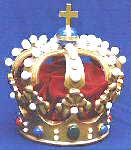
The carved Crown for
HM King Harald V of Norway
As per tradition on the 23 April, St
George's Day the latest Knights of the Garter were officially
announced from Buckingham Palace. On the 16th of June 2003 in
glorious sunshine the pomp and splendour of the Garter procession
could once again be seen as the latest Lady Companion and Knights of
the Garter, along with the other previously installed Knights and
Lady Companions of the Garter began the procession at Castle Hill
walking down from the State Apartments at Windsor Castle to the
lower wards before entering St George's Chapel.
These included the Queens first cousin, Her Royal Highness Princess
Alexandra, The Hon. Lady Ogilvy, GCVO who was then installed in St
George's Chapel as a Lady Companion of the Most Noble Order of the
Garter. This high honour was a personal gift of the Queen in
recognition of her charity work and seniority within the Royal
Family.
Princess Alexandra's appointment as a Member of the Royal Family, is
in addition to the established number of 24 Companions. HRH The Duke
of Edinburgh was created a Knight in 1947, HRH The Prince of Wales
in 1958, HRH The Duke of Kent in 1985, HRH The Princess Royal in
1994, and more recently in 1997, HRH The Duke of Gloucester.
The appointment of Knights and Ladies of the Order of the Garter,
Order of the Thistle, the Order of Merit and the Royal Victorian
Order is in The Queen's Personal Gift and is made without Prime
Ministerial advice. The three lKnights of the Garter who were also
installed in 2003 at Windsor Castle were The Duke of Westminster,
OBE, TD, DL, The Right Honourable Lord Butler of Brockwell, GCB, CVO
the former Cabinet Secretary and The Right Honourable Lord Morris of
Aberavon, QC. These three Crests and the Coronet for HRH Princess
Alexandra were completed early in 2004 and placed in position above
their stalls in St George's Chapel.

The four most
recently completed Knights of the Garter Crests in the artist's
Studio awaiting delivery to Windsor Castle
They are the Crests
for Lord Butler of Brockwell (Badger),
The Duke of
Westminster Crest (Talbot) Lord Morris of Aberavon Crest (Black
Bull)
and the Coronet for
HM The Queen's first cousin HRH Princess Alexandra.
 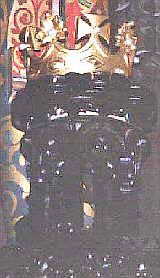 
The completed coronet and crests now in position above the Knights
helms in St George's Chapel Windsor.
On St George's day the latest Knights of
the Garter were again announced to be appointed to this the most
senior and oldest order chivalry. John Major the former Conservative
Prime Minister now becomes Sir John Major. KG, one of the 24 current
Knights. The Queen has also appointed Lady Soames who is the
daughter of Sir Winston Churchill. Her appointment as a Lady of the
Garter is the first non-royal, father daughter appointment in the
orders 650-year history. Lord Bingham of Cornhill who is a former
lord chief justice is the third of this years appointments.
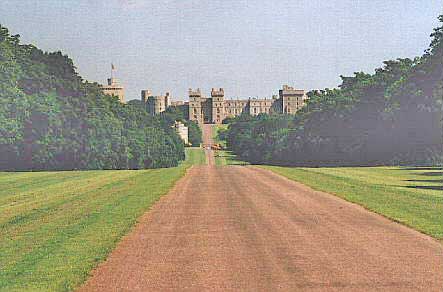
Windsor Castle
Windsor Castle, is the largest inhabited
stronghold in the world and is furnished with works of art from the
Royal Collection. This historic fortress is situated alongside the
River Thames in Berkshire in Southern England and stands proudly on
its wooded chalk ridges which has been the home to Her Majesty Queen
Elizabeth II and earlier sovereigns of England since the days of the
Norman Conquest over 900 years ago. It first existed as a Norman
stronghold built of earth and timber by the forces of William the
Conqueror to control the country after his invasion in 1066.
King William who reigned from 1066 to 1087, was the first Norman
King of England after he defeated Harold Godwinson (King Harold II )
at the famous Battle of Hastings in 1066, where Harold was killed
after being hit in the eye by an arrow. William was subsequently
crowned King of England on Christmas Day. Windsor Castle formed one
of a ring of garrisons built to command the area around London, this
particular site being of strategic importance not only because it
dominated the Thames, then the main freight route into the interior
but also because the castle was only one day’s march from the Tower
of London.
King Henry II rebuilt the castle in stone and began the curtain wall
and the subsequent construction of the Round Tower. Henry III is
credited with then adding the five circular towers to this curtain
wall and Edward III then undertook extensive construction which
included building an inner gatehouse with cylindrical towers, the
College of St George, new Royal apartments for the King and Queen,
the Great Hall and the Royal Chapel. Over the centuries successive
monarchs continued to add to these alterations and improvements
including George III and George IV who were responsible for further
extensive improvements to the castle and are now buried along with
William IV, in the Albert Memorial Chapel.

The Royal Standard
flying above the Round Tower at Windsor Castle,
flown wherever
the Sovereign is present
The only disruption to royal ownership
for 900 years was in 1642 when the English Civil war broke out and
King Charles I who was not popular in Windsor fled to York after
there was rioting in the town.. Consequently having made no attempt
to defend his stronghold at Windsor the castle fell into the hands
of Oliver Cromwell's Parliamentary forces in the charge of Colonel
Venn. Thousands of troops were billeted in the town and Fairfax and
Cromwell were frequent visitors. These forces then proceeded to
steal treasures and plate from St George's Chapel. The dean and
cannons not only had to then endure the indignity of being evicted
from their houses, but also of knowing the nave of the chapel was to
be used as a stable for the horses of the parliamentary forces.
Parliament later commanded "to take care that there be no disorders
and disturbance made in the Chapel at Windsor" However despite this
decree many monuments and windows were smashed and furnishings
looted. The castle itself was then used as a prison for Royalist
prisoners, including the now captured Charles I who was held at the
castle before his trial for High Treason and subsequent execution
outside London's Banqueting Hall at Whitehall. King Charles I body
was bought back to the castle on the 8 February 1649 and was buried
inside St George's Chapel in silence, as the Parliamentary
authorities would not allow the use of the funeral services as
prescribed by the Book of Common Prayer. The location of the king's
tomb which remaining unknown for over 150 years was subsequently
found underneath the floor of the Quire, this vault also contained
the remains of Henry VIII and Jane Seymour.
During the next 11 years England was governed by Oliver Cromwell,
the ' Lord Protector', after the death of Cromwell, the castle
eventually returned as a royal residence when King Charles II
ascended to the throne. The castle and much of the interior survived
however, later to be restored and added to during the reigns of
Charles II, George IV and Queen Victoria. It was however a close
call as shortly after the Civil War, the bill in parliament to pull
the castle down was only defeated by one vote
St
George's Chapel Windsor
The Queen's Free Chapel, or more commonly known as St George's
Chapel is dedicated to the Blessed Virgin Mary. St George and St
Edward the Confessor of St George was founded in 1475 by King Edward
IV as the chapel for the Order of the Garter and was eventually
completed by King Henry VIII 50 years later. 'Free' in this sense
means that the Chapel is a "Royal Peculiar" therefore it falls under
the direct authority of the Queen, rather than any of the normal
Church of England structures. St George's Chapel is also the final
resting place of Ten Royal Sovereigns including Charles I, Henry
VIII and King George VI.
St George's Chapel shares the distinction along with Westminster
Abbey of being not only one of the most revered hallowed Royal
shrines of the British Monarchy, but also one of the most beautiful
buildings of its kind in the world, rich in history, and a place of
prayer. The Chapel belongs to the College of St George which is a
self governing community of priests and laymen.
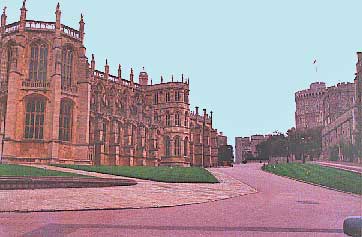
St George's Chapel
Windsor Castle
Dominating the lower ward of Windsor
Castle for over 500 hundred years St George's Chapel one of the most
beautiful ecclesiastical buildings in England, is the home of the
College of St George and the Order of the Garter. It is the last in
a succession of chapels in the castle , of which the earliest was
built in the late 11th century for the needs of the garrison, king
and court. In 1240 King Henry III ordered a chapel to be built in
the lower ward, close to his new apartments. It was dedicated to St
Edward the Confessor and stood on the present Albert Memorial
Chapel.
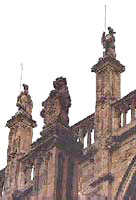 
The Windsor beasts
and gargoyles on the outside pinnacles and buttresses
Unlike most other great churches, the
show front of St Georges Chapel is on the south side facing the
visitor entering Windsor Castle by means of the main King Henry VIII
Gate. The outside of the magnificent building is compact and almost
symmetrical with octagonal chapels protruding from three of its four
corners. The chapel roof which is supported externally by flying
buttresses,. is decorated with fourteen different types of 'Windsor
Beasts' repeating along the roof making seventy-six beasts in total,
of which six of these are unique to the Windsor series.
There has always been a strong connection between the Royal Family
and St George's Chapel. Over the centuries members of the Royal
Family have been baptised, married and buried there. HM The Queen is
closely involved with the life of the College and attends matins at
the chapel on Easter Day, there are also many other times when The
Queen and the Royal Family attend the Chapel, especially every June
when they can all be seen attending the annual ceremony of the Most
Noble Order of the Garter.
The Chapel was also the venue where the service of blessing took
place after the royal wedding took place between HRH Prince Edward
and Sophie Rhys-Jones, the Earl and Countess of Wessex, the funeral
of Her Majesty Queen Elizabeth the Queen Mother and more recently on
the 9 April 2005 the Royal wedding of HRH The Prince of Wales and
HRH Camilla Duchess of Cornwall.
More than 800 guests were at the Chapel which including all the
members of the British Royal Family, European royalty, politicians
and show business stars, to witness Prince Charles and Camilla
pledge their love for one another at the most elaborate Service of
Prayer and Dedication, presided over by the Archbishop of Canterbury
and watched by over 500 million TV viewers worldwide.
 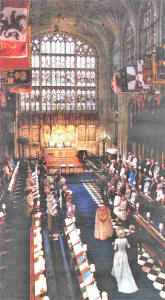 
HRH The Prince of
Wales and HRH Camilla Duchess of Cornwall during the blessing of
their wedding in St George's Chapel in Windsor Castle
Views inside St George's Chapel, Windsor.

The magnificent stone vaulted roof with its carved bosses
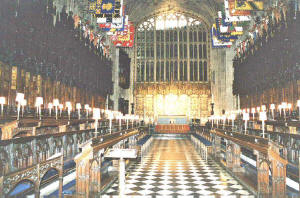 
Choir and Chancel looking West and East
Many of the 30 Royal Crowns, Coronets and Crests carved by Ian G
Brennan on the South and North Stalls within the Choir and Chancel
of St George's Chapel; photographs taken in 2004.
Ian G Brennan was invited to Windsor Castle to give a talk about the
various aspects of his his work as a sculptor. This talk to the
invited audience held in St George's Chapel was not only about the
wide variety of sculptures he has produced for the past seventeen
years for the Royal Household, but also how he starter his career as
a sculptor.

A selection of the unique bronze wildlife sculptures and heraldic
woodcarvings created by Ian which were also on display during his
talk within the wonderful setting of the Nave of St George's Chapel
Each Knight of the Garter is allotted a
stall (seat) in St George's Chapel Windsor Castle and above it is
placed the medieval symbols of chivalry, his banner which was often
carried in battle bearing his coat of arms, these arms were also
often worn as a tabard over his armour which helped to identify him.
On top of the stall is the knights helm (or helmet) on this is
placed his crest or in the case of foreign sovereigns the crest is
replaced with a crown, which again is used as a form of recognition.
 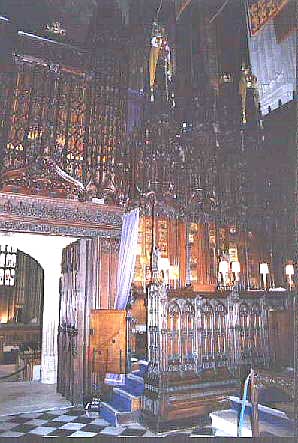
The Sovereign's Stall
- The Prince of Wales Stall
In 1475- 1485 under the medieval
woodcarver William Blakely's direction the magnificent woodwork in
the Choir was produced with later alterations being made between
1787 and 1790 when the stalls were enlarged. At the end of each
block of 'desks' are ornamental tops or 'poppy heads' with each of
the faces ornately carved with various stories. On the north side
the stories are about the Passion and Resurrection of the Lord and
on the south side are stories depicting St George and the life of
the Virgin Mary.
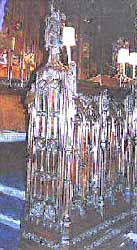  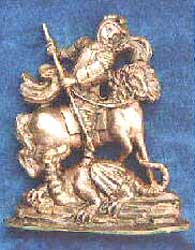
The Princes of Wales
Stall Poppy Head depicting St
George Slaying the Dragon
St George Slaying the Dragon
The above photographs show one end of
these carved desks alongside the Prince of Wales Stall, the photo's
also show a close up of one of these original carved tops. Ian has
recently started producing 6 inches high replica's of one of the
earliest remaining relief carvings depicting St George Slaying the
Dragon remaining in Windsor Castle. Ian carefully replicated every
detail closely following all the original details produced by the
medieval master carver on the relief carving of St George the patron
Saint of England, for whom this historic Chapel has been dedicated.
The helm has mantling hanging either side of it which is symbolic of
the cloth that would have help protected the knight in his armour
from the rain or sun. There is also the half drawn sword which
represents the fact that in theory every Knight of the Garter has
his hand on his sword ready to defend the Sovereign at any time.
When a Knight Companion dies his Banner, Crest, Helm and Sword are
taken down and the insignia returned to the Sovereign. The stall is
roped-off and a laurel wreath bearing his name is placed in it. The
Knights stall is not used again until his Banner is offered to the
Altar. This ceremony which is reminiscent of medieval practices
takes place some time after the Knights funeral which is attended by
members of his family, Knights Companion and Officers of the Order.
The Banner is brought in procession by the Military Knights during
Evensong and is then received by the Dean and placed upon the Altar.
Prayers are said for the Deceased Knight Companion and the Order.
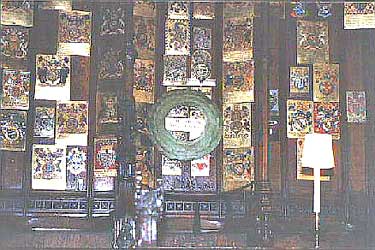

Various stall-plates
- Wreath for a Deceased Garter Knight
The Garter Knights brightly coloured
brass enamel stall-plate showing the knights full coat of arms,
title and the date of appointment to the Order which is affixed to
the back of the stall soon after the instillation service and
remains there in perpetuity. At present there are almost 800 Garter
Knights stall plates in St George's Chapel the earliest surviving
plate is that of Ralph, Lord Basset of Drayton who was elected to
the Order in 1368. He was one of the leaders of the English army
which, led by the Black Prince defeated the French at the Battle of
Poitiers in 1356. The stall-plates in St Georges Chapel provide one
of the best examples of the fine history of heraldic designs during
the past six centuries.
Such is the prestige of the Most Noble Order of the Garter, when Sir
Winston Churchill died in 1965 his Garter Crest depicting a 'Lion
holding a staff' was taken down from above his stall in St George's
Chapel Windsor Castle, the crest was then mounted on a stave and
carried with great ceremony throughout Sir Winston's State Funeral
procession. His coffin placed upon a gun carriage and draped with
the Union Flag, Sir Winston’s insignia as a Knight of the Garter,
his collar, garter and star gleamed in lone splendour upon a black
velvet cushion placed upon the coffin of the gun carriage which was
pulled by a Gun's crew of naval ratings, for the State Funeral
service which was held at St Paul's Cathedral in London.
  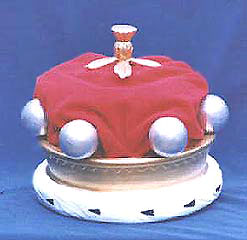
Sir Winston
Churchill's Garter Crest and Stall plate along with the carved and
gilded Coronet carved by Ian G Brennan for Lady Soames; Sir Winston
Churchill's daughter.
Although a number of Garter knights have
been 'degraded' over the years for the crimes of heresy or
cowardice, one of the main reasons that a Knight is removed from the
Order during his lifetime is for Treason against the Sovereign. In
ancient times this would often mean being beheaded, with Henry VIII
alone accounting for six. Between 1387 and 1716 twenty Knights were
removed, six of whom were subsequently reinstated.
Most degradations occurred because a Knight fought on the wrong side
and then lost! Two of the most famous of these disgraced Knights
during this period was " Warwick the Kingmaker" Richard Nevill, Earl
of Warwick who was appointed in 1460 but was later killed at the
battle of Barnet in 1471 and later in the 16th century Edward
Stafford, 3rd Duke of Suffolk incurred the displeasure of Henry VIII
and was executed on Tower Hill at the Tower of London.
During World War II, the crests and swords of the "extra knights"
Emperor Hirohito of Japan and King Victor Emmanuel III of Italy were
removed from the order's St George's Chapel. The conferment of this
high honour has also been refused however, in 1945 when Winston
Churchill's Conservative party was voted out of office Mr.Churchill
refused the Order of the Garter when it was first offered to him. In
private he explained, "I can hardly accept the Order of the Garter
from the King after the people have given me the Order of the Boot."
However, Mr Churchill relented and in 1953 he was inducted into the
order.
Ladies of the
Order
During the Middle Ages ladies were associated with the Order
although they did not enjoy full membership. One of the last
medieval ladies to be honoured was the mother of Henry VII and
grandmother of Henry VIII, Lady Margaret Beaufort. After her death
in 1509 the Order remained exclusively male, except for reigning
queens as Sovereign of the Order. This situation remained until 1901
when Queen Alexandra was made a Lady of the Order by Edward VII .
In 1987 Her Majesty the Queen decided that ladies should be eligible
for admission as Companions of the Order, with the same rank and
privileges as Knights Companions. The first Lady Companion to be
appointed was Lavinia Duchess of Norfolk in 1990, followed in 1995
by the former British Prime Minister Baroness Thatcher. .
Lady companions are now included in the establishment and have the
same rights, duties and privileges as Knights Companions. Their
style and titles is shown as 'LG' after their names, as opposed to
the 'KG' used by Knights Companions. Ladies do not display helmets,
mantles and swords but only their carved Crowns and Coronets are
placed in position above their stalls, The exception is HM the Queen
who as Sovereign of the Order, displays the helmet, mantle, crest
and sword.
Her Majesty Queen Beatrice of the Netherlands joins HM Queen
Elizabeth the Queen Mother, her own mother Princess Juliana and
Queen Margarethe of Denmark as the contemporary Ladies of the Order
and HM The Queen's daughter HRH Princess Ann, The Princess Royal who
was the first Princess since the Middle Ages to be awarded such a
high honour. In 2003 the Queen's first cousin, Her Royal Highness
Princess Alexandra was also installed Lady Companion of the Most
Noble Order of the Garter. Lady Soames who is the daughter of Sir
Winston Churchill was installed as a Lady of the Garter on the 13
June 2005 and is the first non-royal, father daughter appointment in
the orders 650-year history.
The
Procession and Service at St George's Chapel Windsor
Every June, the Knights of the Garter gather at Windsor Castle,
where the new Knights take the oath and are invested with the
insignia of the Order, which consists of the Garter, Star, Riband,
Collar and Mantle.
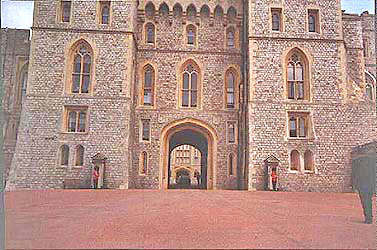
The Knights and
Ladies of the Garter and their spouses receive a royal salute by the
Guards on duty
as they enter Windsor
Castle via the King George IV Gate entrance.
The investiture of the new knights takes
place in one of the oldest parts of the castle, the 12th century
Garter Throne Room. After lunch in the Waterloo Chamber the latest
Lady Companion and Knights of the Garter, along with the other
previously installed Knights and Lady Companions of the Garter began
the procession at Castle Hill walking down from the State Apartments
at Windsor Castle to the lower wards before entering St George's
Chapel
HM The Queen as Sovereign of the Order of The Garter, attends the
Garter service along with other members of the Royal family who are
in the Order, including HRH the Duke of Edinburgh, HRH the Prince of
Wales, HRH the Princess Royal, HRH The Duke of Kent and HRH the Duke
of Gloucester.

HM the Queen with the
Order of the Garter members in Windsor Castle's Waterloo Chambers
Front row ; from left to right : The Duke of Grafton, The King of
Spain, The Queen of Denmark, The Duke of Gloucester, The Princess
Royal, The Duke of Edinburgh, The Queen, The Prince of Wales, The
Duke of Kent, Grand Duke Jean of Luxembourg, The Queen of the
Netherlands, The King of Norway.
Second row ; Page of Honour The Honourable John Bowes-Lyon, Black
Rod Sir Michael Willcocks, Sir Edward Heath, The Duke of Devonshire,
Lord Sainsbury of Preston Candover, The Duke of Wellington, The
Chancellor Lord Carrington, Lord Richardson of Duntisbourne, Lord
Kingsdown, Lady Thatcher, Garter Peter Gwynn-Jones, Page of Honour
Lord Carnegie.
Third row ; Lord Indg, The Duke of Abercorn, Lord Ashburton, The
Register The Dean of Windsor, Sir Edmund Hillary, The prelate The
Bishop of Winchester, Sir Timothy Coleman, The Secretary Hubert
Chessyre, Sir William Gladstone and Sir Anthony Acland.
During the Queens Jubilee Year in June
2002 the crowned heads of Europe gathered at Windsor Castle for the
grand spectacle of the Garter Ceremony and a dinner in the Waterloo
Chambers to celebrate the Golden Jubilee. King Juan Carlos of Spain,
Queen Beatrix of the Netherlands, Queen Margrethe of Denmark and
Grand Duke Jean of Luxembourg all Knights or Ladies of the Garter
all took part in the annual procession down the hill to St George's
Chapel.
They were joined by the Royal Family which included the Queen, the
Duke of Edinburgh, the Prince of Wales, and the Princess Royal and
at the Galilee Porch of the chapel waiting for the procession to
arrive were Grand Duchess Josephine-Charlotte of Luxembourg, Prince
Henrik of Denmark, Queen Sophia of Spain, Queen Sonja of Norway and
the Earl and Countess of Wessex.
On Garter Day, Windsor Castle is closed
to all visitors other than those invited to attend the Garter
Service or to watch the Procession of the Garter Knights to St
George's Chapel. Members of the public (including overseas visitors)
may apply to the Lord Chamberlain at Windsor Castle, to be included
in a ballot for tickets for admission to the courtyard of the Castle
to watch the Garter Procession.
The Chelsea pensioners dressed in their
fine red uniforms prepare to stand to attention when the procession
begins outside the Military Knights quarters. Two military bands
then also take up their positions, one band will positioned near to
the Henry VIII Gateway near to the Guardroom. The other will be
positioned alongside Henry VII Tower. These bands play both during
and after the procession.
On Garter Day when a new Knight is invested, he still receives
exhortation to the Christian Faith, the procession in which he walks
is not only a means of proceeding from the Royal Apartments at the
Upper Ward to the Royal Chapel, but it is also a public witness to
the long tradition of the Sovereign and leaders to the nation giving
their allegiance to God.
The procession itself
is led by the Governor of the Windsor Castle Sir Richard Johns
wearing his blue full
dress uniform of an Air Chief Marshal, with the red ribbon of the
Order of the Bath.
The officers of Arms who are the
purseuivants and heralds then follow wearing their black
knee-breaches and colourful tabards bearing the Royal Arms, their
role on the day being to marshal the procession. Heralds were
originally appointed to organise and make the announce at
tournaments, to act as diplomats and to record the various insignia
borne by the individuals and to carry as a non combatant messenger,
messages from place to place, as well as to make declarations of
war. In the early Middle Ages the Chief herald was called the
Marshal. In those days when it was the custom for the King himself
to go to war, it was therefore the marshals duty to 'marshal' the
army in groups with their banners and 'coats of arms'.
The most newly created Knights of the Garter walk down at the front
with the more senior Knights at the end, these Knights wear the dark
blue velvet robes adorned with the cross of St George, surrounded by
the Garter motto: "Honi Soit Qui Mal Y Pense" on the left breast .
These robes of blue velvet mantle and red velvet hood worn on the
right shoulder, black velvet hat and white Ostrich plumes. These
robes are also open on the right side to give freedom to the
sword-bearing right arm.
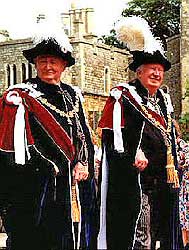

Field Marshal Lord
Bramall and Sir Edward Heath - Margaret, Baroness
Thatcher and Sir Edmond Hillary
The Knights are then followed by the
members of the Royal Family which include the Princess Royal and the
Prince of Wales with the officers of the Order following behind
wearing their scarlet and blue robes these includes the Secretary of
the Garter, who is responsible for the organisation of all the
various aspects of the ceremony, the Register who is the Dean of
Windsor, Garter King of Arms, the Chancellor, Lord Carrington who is
a Knight of the Garter himself and the Prelate, the Bishop of
Winchester, who reads the lesson and gives the blessing during the
service in St George's Chapel.

HRH the Princess
Royal and HRH the Prince of Wales
during the procession
outside St George's Chapel at Windsor Castle.
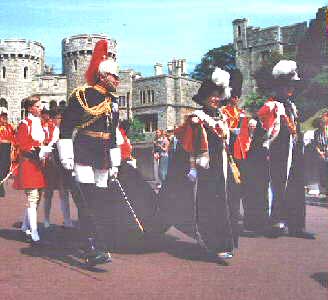
HM the Queen and HRH the Duke of Edinburgh
This group of people are then followed
in the procession by the Sovereign, who walks with the Duke of
Edinburgh. The Queen's train is carried by two pages who in turn are
flanked by the Field officer in Brigade Waiting who is a Guards
officer, and either a Life Guard or a Blues and Royal officer. The
procession down to St George's Chapel finishes with a detachment of
the Yeoman of the Guard, walking in fours wearing their fine Tudor
uniforms.
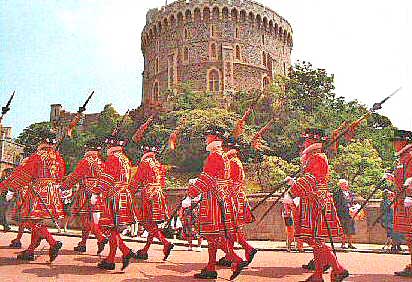
The Yeoman of the
Guard in procession
The Yeoman of the Guard were created by
Henry VII in 1485, following his victory in Bosworth. Their unique
Tudor uniform of a scarlet doublet is embodied with a Tudor crown
and the roses of York and Lancaster.The uniform including red
breeches and stockings is complemented with black buckled shoes
adorned with rosettes.They are not the same as the Yeomen Wardens of
the Tower of London and the nickname 'Beef Eaters' belong only to
the men of the Tower.
The Garter procession arrives at the Great West Door to enter St
George's Chapel, the Choristers (boys) and Lay Clerks (men) who form
the Chapel Choir, along with the Minor Cannons and the Cannons of
Windsor are already lined up in the Nave ready to lead the
Procession through the Nave into the Quire.
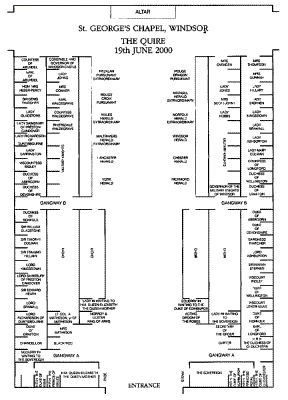
Plans of the seating
in the Quire on the 19th June 2000
At the instillation ceremony in 2002,
after the Procession entered the Quire, everyone went to his or her
appointed seat, The Queen however remained by her stall and the
newly appointed Knight remained in the Quire. After the National
Anthem was played. Lord Carrington, the Chancellor of the Order
called out the name of the new knight in response to the Queen's
bidding : "It is our pleasure that the companion newly invested be
installed." King Harald was then conducted to his stall. The service
of Thanksgiving then followed, during this the choir proceeded to
sing a Te Deum - which is a traditional hymn of praise to God, which
was followed by prayers for the Order and the Sovereign.
This service of Instillation was relayed from St George's Chapel by
loudspeakers to those waiting outside. During the Service, horse
drawn Landaus and various cars were driven down the procession route
to convey The Queen, Foreign Sovereigns, members of the Royal family
and the Knights and Ladies of the Garter, their spouses and the
Officers of Arms are also driven back up the hill at the end of the
service.

After the service the
military band and route lines prepare to leave
The
Garter Knights, Crowns Crests and Coronets
The Crowns, Coronets and Crests for the Royal Knights, Extra Knights
and Ladies, Knights and more recently the Lady Companions of the
Most Noble Order of the Garter, are all individually made for each
Knight of the Garter and Bath and are therefore totally unique. In
the case of Sovereigns, the Crest is replaced by a carved State
Crown. Shown below is just a small selection of the
three-dimensional Heraldic Sculpture for the Royal Knights, Extra
Knights and Ladies and Knight and Lady Companions of the Order of
the Garter and Knights Grand Cross of the Order of the Bath, Ian G
Brennan has been commissioned to produce for the past Seventeen
years.
Each Royal Crown, Coronet or Knights Crest usually take Ian around
two to three weeks to carve before he is ready to start the painting
and gilding. The Royal Crowns and Coronets are carved with gilded
rims set with gilded jewels and pearls, or when appropriate the
jewels and pearls are coloured like jewels. The golden arches Ian
makes for many of the different Sovereigns Crowns, are fitted with
rows of large white or silver carved wooden pearls which are placed
above either open Crowns or upon carved crimson caps.
They have all been carved from lime wood prior to being painted and
gilded. Today the modern Knights Crowns and Crests are no longer
fixed upon the Knights helm (helmet) and used in battle, but instead
placed upon the Knights helms in St George's Chapel Windsor Castle
and Henry VII Lady Chapel in Westminster Abbey
A small selection of
these carved and painted Coronets and Crests produced by Ian G
Brennan; all are between 12 - 28 inches high.


The Crest of Sir Edmund Hillary (Kiwi holding an Ice Axe), Duke of
Devonshire (Snake Crest)
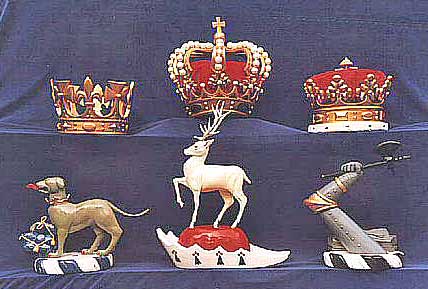
Top Row :
The carved and gilded Crowns and Coronets, Princess Royal/ King Juan
Carlos of Spain / Duchess of Norfolk
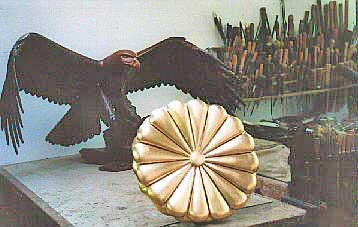
The woodcarving of the Chrysanthemum Crest commissioned for Emperor
Akahito of Japan

The completed Crest for the Emperor of Japan in position
alongside Ian's most
recent commission the Crown for HM King Harald of Norway.
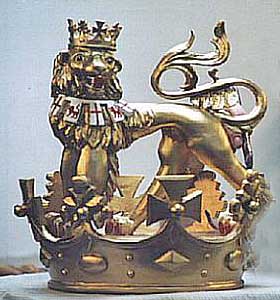
The carved Crest for HRH The Duke of Gloucester

HRH The Duke of
Gloucester's crest having now been placed in position
alongside the coronet
and crests for HRH The Princess Royal,
HRH The Duke of
Edinburgh, The Sovereign, HM Queen Elizabeth II, in St George's
Chapel Windsor Castle.

HRH The Prince of Wales crest alongside HRH the Princess Alexandra
coronet and the crest for HRH The Duke of Kent.
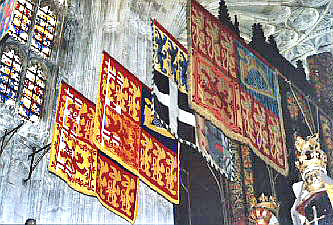 
A selection of Royal and Garter Knights Banners
Order of the Garter as at June 2005
Announcements of the creation of new Garter Knights always takes
place on St George's Day, 23rd April
Royal Knights
HM Queen Elizabeth
HRH The Duke of Edinburgh 1947
HRH The Prince of Wales 1958
HRH The Duke of Kent 1985
HRH The Princess Royal 1994
The Duke of Gloucester 1997
Extra Knights and Ladies
HRH The Grand Duke Jean of Luxembourg 1972
HM Queen Margrethe of Denmark 1979
HM King Carl Gustaf of Sweden 1983
HM King Juan Carlos of Spain 1988
HM Queen Beatrix of the Netherlands 1983
The Emperor of Japan 1998
HM King Harald of Norway 2001
HRH Princess Alexandra, The Hon. Lady Ogilvy 2003
Knight and Lady Companions
The Duke of Grafton 1976
The Lord Richardson of Duntisbourne 1983
The Lord Carrington 1985
The Duke of Wellington 1990
Field Marshal the Lord Bramall 1990
Sir Edward Heath 1992
The Viscount Ridley 1992
The Lord Sainsbury of Preston Candover 1992
The Rt Hon Sir Ninian Stephen 1994
The Lord Kingsdown 1994
The Lord Ashburton 1994
The Baroness Thatcher 1995
Sir Edmund Hillary 1995
Sir Timothy Colman 1996
The Duke of Abercorn 1999
Sir William Gladstone, Bt 1999
Field Marshal The Lord Inge 2001
Sir Antony Acland 2001
The Duke of Westminster 2003
The Right Honourable Lord Butler of Brockwell 2003
The Right Honourable Lord Morris of Aberavon 2003
The Right Honourable The Lady Soames 2005
The Right Honourable Sir John Major 2005
The Lord Bingham of Cornhill 2005
|



























